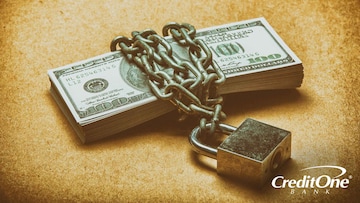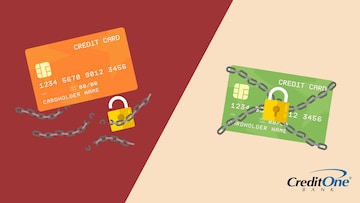
Using a Secured Credit Card To Build Credit
September 13, 2024
Using a secured credit card strategically and responsibly is one of the best ways you can build your credit. However, it’s important to know how to obtain and use one of these cards before pursuing this option.

If you’re in the process of trying to build — or rebuild — your credit, you may have discovered that it’s tough to do so without actually having any credit. Most credit card companies want to see that you’ve demonstrated responsible credit usage prior to granting you a credit card, but how are you supposed to demonstrate responsible usage if you don’t have any credit to use responsibly?
Should you find yourself in this Catch-22, a secured credit card may be a way around this predicament.
What Is a Secured Credit Card?
Most people are referring to an unsecured credit card when they use the term “credit card.” Unsecured credit cards provide you with credit without the need for any collateral. These types of credit cards are typically issued based on your credit score and the information in your credit reports, which are used by potential creditors to assess your creditworthiness. If a card issuer deems you to be a suitable risk based on your credit score, the information in your credit reports, your income, and potentially a few other factors, then they’ll likely approve you for one of their credit cards.
A secured credit card, on the other hand, is secured by collateral in the form of a refundable deposit made by you. The amount of the deposit is typically for the credit card’s limit, but it varies by credit card issuer and can also depend on your credit history, if you have one. This collateral makes you less of a risk to a credit card issuer, so even people with low or no credit scores can usually get a secured credit card — so long as they can afford the required security deposit and any fees associated with the card.
You apply for a secured credit card the same way you do for an unsecured card, by f illing out an application. If you’re accepted, you’ll then make your refundable deposit to the credit card issuer. From that point forward, a secured credit card works just like an unsecured card. You make purchases with the card, you receive a statement at the end of each billing cycle, and then it’s up to you to make at least your minimum payment by the due date each month.
Just like with an unsecured credit card, a secured credit card issuer should report your account activity to the three main credit bureaus. It’s this reporting that helps a secured cardholder to build a credit history.
How Do I Get a Secured Credit Card?
To obtain a secured credit card, you’ll want to do the following:
Shop around and compare different options. You will want a card with a low interest rate and good rewards for your most common purchases.
Submit an application for your card. This will ask for various personal details like your name, Social Security number, and monthly income.
Make a security deposit. A secured credit card requires collateral and will equate to the amount of your credit limit in addition to any fees.
Wait for approval. The bank will review your application and confirm your deposit before approving the card.
If you later want to close out the credit card, you can usually receive a refund of your security deposit if your account is in good standing.
How To Increase Limit on a Secured Credit Card
It’s sometimes possible to increase your credit limit on a secured credit card. This will depend on the parameters of your contract and the standing of your account. Your agreement will also outline the steps you need to take to increase the limit on your credit card if allowed. In some cases, you’ll need to deposit more money, while in others you may be eligible for an automatic increase after a certain number of payments are made on time.
How To Use a Secured Credit Card to Your Advantage
To maximize the benefits to your credit score, it’s vital to understand how to properly use a secured credit card.
- Accentuate the Positive in Your Payment History
- Keep Your Credit Utilization Ratio on the Low Side
- Practice Good Credit Habits
- Graduate to an Unsecured Credit Card
Payment history is the biggest factor in determining your credit score, and using a secured credit card to help you build a payment history is one of the main reasons to opt for this kind of card. This means you’ll want to make your payment history as positive and flawless as possible.
The way to do this is to make your payments on time, every time. That means paying at least the minimum amount due by the payment due date each and every month. A payment not received by the credit card company by the due date is considered late, even if it’s postmarked prior to the due date. And even if your payment is on time, if it’s for less than the minimum amount due — or if you make multiple payments that don’t add up to at least the minimum amount due — it’s technically a missed payment.
Do what you need to do to make sure you’re building a positive payment history with your secured credit card. Set up automatic payment reminders, sign up for auto-pay if your credit card company or bank offers it, and make online payments or payments via your credit card’s mobile app to avoid mail delays. Remember, building a negative payment history with a secured credit card defeats the whole purpose of getting a secured card in the first place.
Your credit utilization is an important mathematical equation that can impact up to 30% of your credit score. It’s calculated by dividing the sum of your outstanding revolving credit balances by the sum of your revolving credit lines.
If your secured credit card is the only form of revolving credit on your credit report, you’re going to want to keep your outstanding balance on the low side to keep your credit utilization ratio below 30%, which many experts recommend, although it’s not a hard and fast rule.
If your secured credit card has a limit of $500, you’re going to want to keep your outstanding balance below $150, which is 30% of $500. A higher outstanding balance could raise your credit utilization ratio, which could, in turn, lower your credit score.
While you’re building credit with your secured card, consider making smaller purchases that will keep your credit utilization ratio low and will be easy to pay off each month. As you start to build a history of steady, on-time payments, you can purchase more each month but try not to exceed 30% of your card’s credit limit.
Practicing good, healthy credit habits on a secured credit card should provide you with the tools you need to keep improving your credit when you switch over to an unsecured credit card. Along with making consistent, on-time payments and keeping your credit utilization below 30%, these habits include not making purchases with the card that you can’t afford, minimizing the amount of interest you pay, and minimizing fees and penalties you can easily avoid.
Think of your secured credit card as a sparring partner as you prepare for the title fight: an unsecured credit card. Whatever habits you develop sparring — good and bad — are the ones you’ll take into the ring with you when it’s time for the main event.
Nobody wants to use a secured credit card forever. A secured card is a stepping stone to additional credit that should probably ultimately include an unsecured credit card or two.
Some secured credit card companies may offer you an unsecured card once they feel your credit history justifies one. Alternatively, if you’re happy with the issuer of your secured card, you may contact them to discuss moving up to one of their unsecured credit cards.
Of course, you’re welcome to apply for an unsecured credit card with any credit card issuer you choose at any time. However, you’ll want to first wait to improve your credit with your secured card to increase your chances of approval and minimize your interest rate. Further, keep in mind that every time you apply for a credit card, the card issuer does a hard inquiry into your credit report, which typically lowers your credit score by about five to ten points.
How Much Will a Secured Credit Card Raise My Score?
There’s no simple answer to this question. If you have little to no credit history or an existing score that is good, you’ll likely see relatively strong gains. However, if you’re fighting an uphill battle against existing debt and poor credit history, the rise in your score may be more modest. Again, as previously mentioned, you’ll see the best outcomes if you approach the use of your card responsibly and strategically.
How Fast Does a Secured Credit Card Build Credit?
This can vary depending on the specific circumstance. However, typically, you’ll see changes to your credit score within a few months of opening the credit card. It’s important to remember, though, that significant improvement to a poor credit score may take up to several years. How fast you can improve your credit score is affected by many factors, such as the particulars of any negative items on your credit report.
A secured credit card may not be your first choice when looking for a credit card. But, if your credit situation dictates that it’s the only type of credit card you can get, it can be an invaluable tool in helping you to establish, or reestablish, your credit. Further, if you use it responsibly, you can hopefully graduate to an unsecured card in the future.
If you’re interested in getting a secured card, you can see if you pre-qualify for a secured card from Credit One Bank– checking to see if you’re pre-qualified is free and will not harm your credit score.



